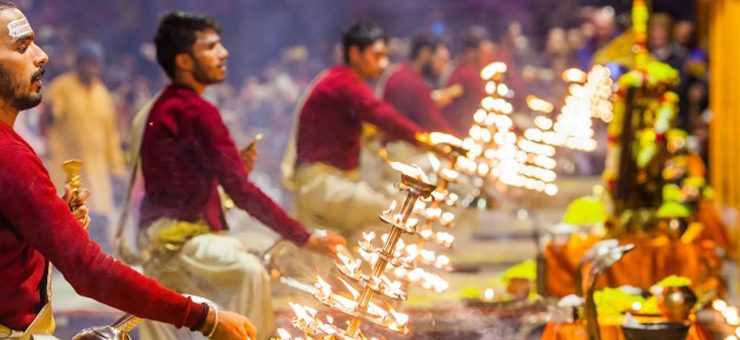Spirituality pervades the land that is India. Each stone, river, stream and mountain has a thousand-year old history behind it, and some part of that history has a tale to tell.
India’s glorious diversity extends to religious life as well. Eighty-five percent of Indians follow various religions. Boasting a lively pantheon of deities that smile from exquisitely sculpted temple gopura, the Hindu religion absorbs beliefs and philosophies from all over, thus practices frequently differ from place to place. Nevertheless the basic tenets of Hinduism were laid out in the Vedas, and describe the goal of uniting with Brahma, the creator, via a life of asceticism and meditation. Hindu belief includes the concept of samsara, the cycle of death and rebirth, and release from samsara, or moksha.
Muslims make up a significant ten percent of the population in all over India, mosques are almost as ubiquitous as temples. Islam worships one God, Allah, eschews pork, and Muslim women are encouraged to veil themselves. Muslims are no longer a large part of the population, but their impact throughout Indian history is felt in its architecture and in several cities.
Other significant religious groups include the Jains and Buddhists, once much more prominent than they are now, and shoes temple architecture has left its mark on the Indian landscape, the Sikh community, Christians, and Zoroastrians.
Places of spiritual importance abound in India. From Badrinath, Kedarnath, Uttarkashi, Rudraprayag in the north to the numerous temples and places like Kanyakumari and Mammalapuram in the South, there is no dearth of spiritual places.
Badrinath
Badrinath set on the mountains at a height of about 11,000 feet, according to mythology, it is here that Lord Vishnu spent innumerable years in meditation. Lord Badrinath is worshipped here and Badrinath finds favor with all Hindus, but it is all the more sacred for the devotees of Vishnu.
Kedarnath
Kedarnath situated at a height of 3,581 metres, the Kedarnath shrine is dedicated to Lord Shiva. Holy places include the Kedarnath Temple, Shankarachary Samadhi and many others. Kedarnath is in close proximity to other places that are both beautiful and holy like Sonprayag, Gaurikund, Madmaheshwar and Tungnath.
Uttarkashi
Uttarkashi is known for its temples dedicated to Parshuram, Datatryea, Annapurna, Kali, Bhairon and other gods and goddesses. It is situated at an altitude of 1,550 meter at the banks of the Bhagirathi river.
Vaishno Devi
Vaishno Devi cave temple situated at a height of 5,200 feet above sea level in Jammu and Kashmir, is dedicated to the three goddesses, Durga, Lakshmi and Saraswati. The cave has a very low height – just 1.5 m. Devotees have to bend double for the first few yards and then wade through ankle deep chill water to see the deity. Devotees have to undertake an arduous 13 km trek to reach the temple. A staggering 15 to 20,000 people come to the temple everyday. It is believed that the arm of the goddess Sati fell here. It is only temple in India where all the three goddesses are worshipped in one place.
Other temples in the area are, Charan Paduka Temple, Ban Ganga Temple, Ardh Kuwari and the Bhairon Temple.
Kanyakumari
Kanyakumari located at the southern tip of India, it is here that the 1000 year old Guganathaswamy Temple, the Kumari Amman temple where Parvati as Devi Kanya, the Virgin Goddess is worshipped and the modern monuments of faith, the Vivekanand Memorial and the Gandhi Memorial are situated.
Mamallapuram
Mamallapuram, also known as Mahabalipuram, the city plays host to fourteen cave temples, nine monolithic shrines, three stone temples and four relief sculptured rock panels. Thiruvanamalai – according to tradition, it was the town of Lord Shiva. Located at the foothills of the Arunachala hill, of the numerous temples dedicated to Shiva, the most important is the Arunachal Temple.
